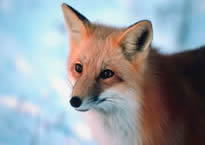Wildlife - Species

Species Specific Regulations
Red Fox
Licenses: Hunting License required.
Limits: Weapon restrictions according to game zones please check for Limitations.

Red fox tracks
Red Fox (Vulpes vulpes)
Description
The overall size of the red fox is slightly larger than the gray fox and the muzzle is longer. The general color ranges from a pale orange to a deep cherry red. The legs are black and the tail is tipped in white.
Average Size
The red fox stands about 16 inches at the shoulder and weighs 8 to 13 lbs.
Life Expectancy
The oldest recorded red fox from South Carolina was 9 years old.
Preferred Habitat
The red fox favors open areas mixed with small wood lots and hedgerows. In the Pee Dee region of the state it has found an ideal home around tobacco fields and commonly digs dens under old abandoned tobacco barns. Since red foxes do not climb trees like gray foxes do, they use underground dens for escape and resting. Red foxes are also numerous on the pasture lands of the Piedmont region.
Range
Red foxes are found in all of the contiguous states but are absent from portions of the southwest and high plains. They are found statewide in South Carolina with highest populations in agricultural areas.
Food Habits
Red foxes feed on rabbits, mice, birds, and insects and also eat fruits and berries. Carrion will be eaten when found. They are opportunistic feeders, taking any acceptable food in proportion to availability.
Reproduction
Peak Breeding Activity
Red foxes are monogamous, breeding between December and February.
The young pups begin to venture outside the den at 5 weeks and are weaned at 2 months. The den is abandoned after about 3 months.
Gestation
53 days, and the litter size ranges from 4 to 8.
Miscellaneous
Red fox populations are largely controlled by sarcoptic mange and associated secondary infections. Red foxes are also subject to rabies and predation. Habitat competition from coyotes also depresses red fox numbers. The annual mortality rate is estimated at 60%.
Red foxes are not native to South Carolina but were introduced by houndsmen during the late 1600s from New England and Europe. Though not as numerous as gray foxes, red foxes are common in South Carolina. Numbers of red foxes are declining in other southeastern states with the invasion of the coyote. It is not certain whether coyotes prey upon red foxes or simply out-compete them for the available habitat. As coyotes expand their range into South Carolina, red fox populations are expected to decline here as well. The red fox is the most popular fox among houndsmen because of its crafty and elusive nature.
Publications and Literature
Baker, O.E., Carmichael, D. Breck, South Carolina Furbearers. Wildlife and Freshwater Fisheries Division. Columbia, South Carolina
Fur Harvest Hunting and Trapping are provided in the Fur Harvest Brochure which is a summary of the state statutes regarding the commercial harvest of furbearers. Applicable statutes are listed in parentheses at the end of each section of this brochure. Copies of actual statutes of the SC Code of Laws are available online from the SC Legislature at www.scstatehouse.gov or by writing: Furbearer Program, SC Department of Natural Resources, P.O. Box 167, Columbia, SC 29202.
Some of the files above are provided in the Adobe® Acrobat® (PDF) format. Adobe® Reader® is required to open these files and is available as a free download from the Adobe® Web site.
Jay Butfiloski - Furbearer Project Supervisor
SCDNR Furbearer Project
P. O. Box 167
Columbia, SC 29202-0167
Phone: 803-734-3886
Fax: 803-734-6020
E-mail: ButfiloskiJ@dnr.sc.gov

